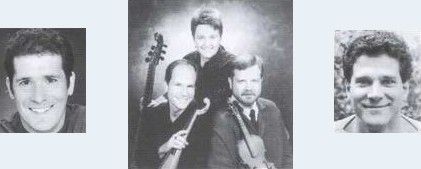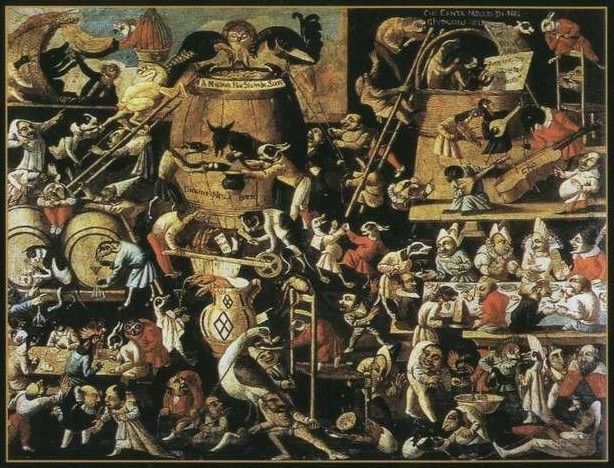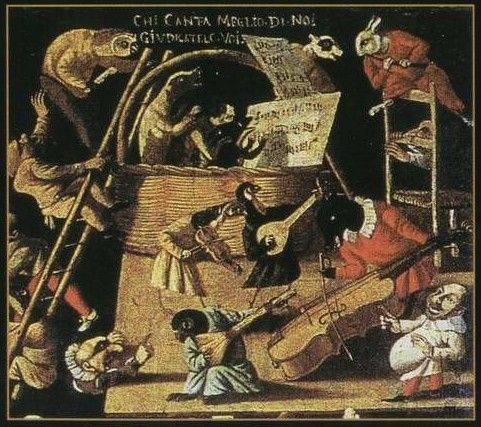
medieval.org
Harmonia Mundi USA 90 7226
1997
01 - Suite of Branles [3:09]
02 - Johannes STOKHEM. Je suis d'Alemagne [1:39]
tenor
03 - Basse dance. Marchez là dureau [1:06]
04 - Puis qu'aultrement - Marchez là dureau [2:32]
05 - Antoine de FÉVIN. Soubz les branches - En La rousée de May [4:19]
tenor, countertenor, baritone
06 - Antoine de FÉVIN. Il fait bon aimer l'oyselet [4:30]
countertenor
07 - Bon vin [2:45]
tenor, countertenor, baritone
08 - La Gelosia [1:38]
09 - Petit vriens [1:50]
10 - La danse de Cleves [2:38]
arr. Ross W. Duffin
11 - En douleur et tristesse [6:11]
12 - La belle se siet [2:03]
countertenor
13 - En amours n'a sinon bien [3:33]
tenor
14 - My, my [2:51]
15 - J'aimeray mon amy [1:35]
16 - Belles tenés moy - La triquotée [0:51]
17 - Rolet ara la tricoton - Maistre Piere - La tricotée [1:14]
countertenor
18 - Amours m'ont fait [3:21]
tenor
19 - Petit fleur [1:25]
20 - Faisons bonne chere [1:05]
21 - Reveillez vous, Piccars [3:28]
tenor, countertenor
22 - L'autrier quant je chevauchoys [3:33]
countertenor
23 - Clément MAROT, Thoinot ARBEAU. Jouissance vous donneray [2:11]
24 - Quant je suis seullecte [4:02]
tenor, countertenor
25 - Héllas! mon cueur n'est pas à moy [4:10]
countertenor
26 - Antoine de FÉVIN. Faulte d'argent [2:45]
tenor
27 - Antoine BUSNOIS, Adrian WILLAERT. Vostre beauté - Vous marchez du bout pié [1:11]
tenor, countertenor

The Newberry Consort
Mary Springfels
Mary Springfels, vielle, rebec, Renaissance viola da gamba
David Douglass, vielle and rebec
William Hite, tenor
Drew Minter, countertenor and harp
Tom Zajac, baritone, harp, Renaissance recorders and flutes,
hurdy-gurdy, bagpipes, percussion
INSTRUMENTS AND THEIR MAKERS
Tom Zajac plays:
Bagpipe, Fritz Heller, 1985
Hurdy-gurdy, Lyn Elder, 1980
Hurdy-gurdy, George Kelischek, 1978
Three-hole pipe, Thomas Prescott
Tabor drum and tambourine, Ben Harms, 1990
Portuguese folk tambourine
Renaissance flute in C and Renaissance alto recorder, Philip Levin 1988
Renaissance flute in D, Ron Leszewski, 1978
Renaissance tenor recorder, Thomas Prescott, 1996
Tenor sackbut, Frank Tomes, 1989
Harp, Lynn Lewandowski, 1994
Mary Springfels plays:
15th century lute, Lawrence Brown, 1978
Vielle, Lynn Elder, 1980
Renaissance viola da gamba, Helmut Muenzberger, 1988
(thanks to Alice Robbins for the loan of this instrument)
David Douglass plays:
Vielle, Eugen Sprenger, 1965
Rebec, Arthur Douglass, 1975
Rebec, Lyn Elder, 1980
Drew Minter plays:
Harp, Lynn Lewandowski, 1981
Recorded November
9-11, 1997, Methuen Memorial Music Hall, Inc.,
Methuen, Massachusetts
Executive Producer: Robina G. Young
Sessions Producer: David Douglass
Recording Engineer: Brad Michel

VILLON to RABELAIS
16th Century Music
of the Streets. Theatres, and Courts
The lives of François Villon (1431—?/1463) and
François Rabelais (1490?/1494-1553) circumscribe a luminous
period in French literature, and their writings, while quite different
from one another formally, lean toward the personal and burlesque, full
of slang and local color. This picturesque quality arises in part from
their unofficial status as writers for neither managed to garner noble
patronage. Villon lived by his wits in the Paris underworld, amassing a
substantial criminal record of theft and even manslaughter that nearly
brought him to the gallows before he was exiled from Paris. Rabelais
played the role of secular cleric to better gain than Villon, bur he
too suffered eventual exile when the Sorbonne censured his Gargantua
and Pantagruel for their ribald subversion of authority. Both writers,
then, reported on French life from unique perspectives, Villon
complaining about city life and Rabelais poking fun a the monastics and
scholastics he knew so well.
In the same spirit as Villon and Rabelais, contemporary composers such
as Loyset Compère, Antoine Busnoys, and Antoine de Févin
took up the idioms of popular urban songs in their written
compositions, spicing up the polyphonic chansons they wrote at court
with texts and tunes borrowed from le menu peuple. The
repertory which resulted combined lofty verse extolling unrequited
amour courtois with popularesque poetry that promoted sexual adventure
in chansons written in both high and low musical styles.
Traditionalists among court composers continued to aim high, choosing
poems written in one of the fixed forms of rondeau, ballade, or
virelai that had governed lyric production since Machaut.
Equally fixed were the subjects proper to courtly verse, which reworked
themes of hopeless desire for a distant or cruel mistress, or, less
often, for a male lover, as in "Amours m'ont fait." Perhaps because
15th century rhetoric so carefully prescribed the forms and topics of
poetry, word play became paramount, and highly-coded language typifies
the school of the grands rhétoriqueurs who furnished
polyphonists with so much chanson verse. "En douleur et tristesse"
typifies the courtly art with its strophes of loving servitude and rich
four-part polyphony. "Quand je suis seullecte" is a rondeau
that beautifully alludes to this highest style both formally (fixed
form poetry) and musically (relatively complex polyphony) at the same
time as the stanzas undercut the "purer" sentiment of the refrain with
phallic references to a distaff and the wakefulness of sexual
irritation.
Combinative chansons with multiple texts take the admixture of high and
low to a new level, playing on the conceit of a love-death that
exhausts sexual desire. This rich polyphony of texts—some as
raunchy as the explicit superius of "Soubz les branches/En la
rousée de May/Jolis mois de May"— was matched with
exquisite counterpoint. Yet the stunning musical effect of songs like
these in no way negates their weird mix of courtly and carnivalesque
lyrics. Rather, they point to a growing taste at the court of Louis XII
for verse with slighter tone set polyphonically.
One important source of friskier songs was the Parisian public theater.
"Faulte d'argent," "La triquotée," and "Je suis d'Alemagne"
would all have been heard there, performed by town minstrels and
play-acting societies like the Enfants sans soucis, of which
Clément Marot, the author of "Jouissance vous donneray," was a
member. Sometimes, however, the grands rhétoriqueurs
penned verse in the low style, though rarely as smutty as the chansons
rustiques from the theater. Many of the monophonic chansons
included here originated at the court and are drawn from a sumptuous
manuscript of faux-rustic songs for gentle pleasure. Finally, popular
chansons were often reworked as basse danses. The basse
danse was the most intricate of the social dances at court,
requiring a rhythmic surety of the dancers unknown in simpler dances
like the bransle, which sat at the bottom of the social scale.
In dance reworkings, the song tune becomes a stretched-out tenor line
above which new melodies are improvised, a technique audible in the basse
danse "Marchez là dureau" where the rocking minor thirds of
the monophonic song can be heard quite clearly in the tenor. Other
instrumental pieces, such as the set beginning with "La Gelosia," were
improvised over chanson melodies that proceeded in tempo in the tenor.
Dances themselves were organized into suites cast in a sort of rhythmic
acceleration like the bransles offered here.
If much of this music sounds intimate and even diminutive, one
gargantuan feature is its wealth of instruments. Rabelais details
Gargantua's education with the humanists where he read the classics and
learned rhetorical skills. After dinner, Gargantua played cards, dice,
and music in order to develop an affection for arithmetic and the
mathematical sciences, which aided digestion:
Après se esbaudissoient à chanter musicalement à
quatre et cinq parties, ou sus un theme, à plaisir de gorge. Au
reguard des instrumens de musicque, il aprint jouer du luc, de
l'espinette, de la harpe, de la flutte de Alemant et à neuf
trouz, de la viole, et de la sacqueboutte. Gargantua
(Afterwards they would rejoice in singing musically in four or five
parts, or on a theme, at the throat's pleasure. Regarding musical
instruments, he learned to play the lute, harpsichord, harp, the German
flute [traverso] and the nine-holed flute [recorder], the viol, and the
sackbut.) Gargantua
To the Rabelaisian instrumentarium, this recording adds the vielle (an
instrument for blind beggars, according to one 16th century source),
the rebec (for minstrels), the hurdy-gurdy, and two kinds of bagpipes,
besting even Gargantua himself.
